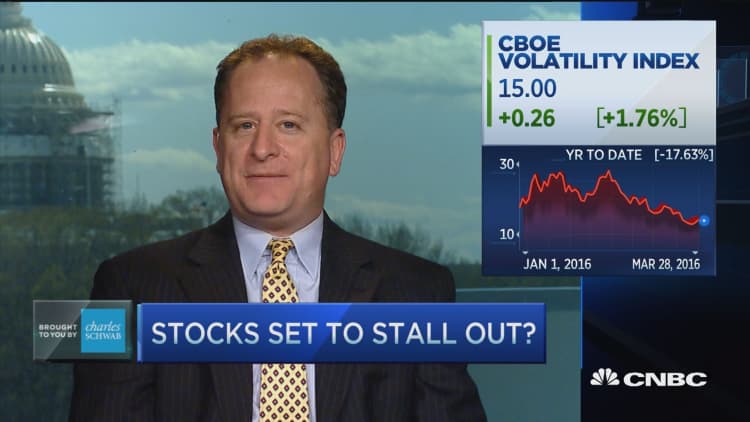


True to stereotype, March came in like a lion and is going out like a lamb — for the markets. Although when it come to stocks, the lamb may not be a quiet enough animal to serve as an adequate metaphor.
As of midday trading, Tuesday is set to be the 11th-straight day that the will close less than 1 percent above or below its prior close. Stocks haven't seen that long of a comparable period since June, when the S&P refused to move 1 percent for 12-straight sessions.
Over the past two years, the S&P has only seen seven prior stretches in which a 1 percent move has not been seen for this long or longer. But examining what broke those periods may be instructive.
| Time period | Number of sessions | Move that broke streak |
|---|---|---|
| June '15 | 12 | -2.09% |
| Mar. '15 to Apr. '15 | 12 | -1.13% |
| Feb. '15 to Mar. '15 | 16 | -1.42% |
| Nov. '14 to Dec. '14 | 26 | -1.63% |
| Aug. '14 to Sep. '14 | 32 | -1.62% |
| Apr. '14 to July '14 | 62 | -1.18% |
| Mar. '14 to Apr. '14 | 15 | -1.25% |
As it happens, the moves that have taken the S&P out of these quiescent spells have exclusively been to the downside.
One might protest that big moves tend to be more to the downside; that stocks, as the saying goes, take the stairs up and the elevator down. This would explain why the first 1 percent move in a while would tend to take stocks lower, rather than higher.
But this intuition isn't borne out by the facts. Isolating all of the 1-percent-or-greater moves the S&P has experienced over the past two years shows that more of them have been gains than losses. And averaging together those 1-percent-or-greater moves yields a gain of 0.01 percent, versus a gain of 0.02 percent on all market days in the past two years.
At the same time, it would probably be folly to get short stocks or long volatility in anticipation of such a drop. These quiet periods can last quite a long time. For instance, in the middle of 2014, the S&P moved less than 1 percent for 62 straight sessions.
If that transpires once again, then April will both enter and exit like that proverbial lamb.






